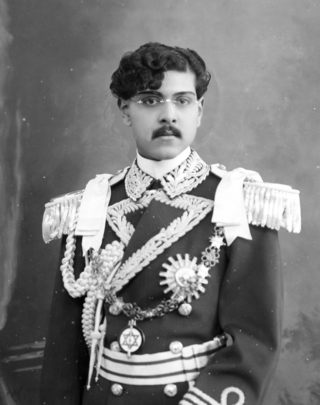
Tribhuvan Bir Bikram Shah Dev, was King of Nepal. Born in Kathmandu, the capital city of Nepal, he ascended to the throne at the age of five, upon the death of his father, Prithvi Bir Bikram Shah, and was crowned on 20 February 1913 at the Nasal Chowk, Hanuman Dhoka Palace in Kathmandu, with his mother acting as regent. At the time of his crowning, the position of monarch was largely ceremonial, with the real governing power residing with the Rana family.
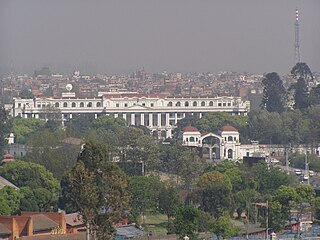
Singha Durbar is a palace in Kathmandu, the capital of Nepal. The palace complex lies in the centre of Kathmandu, to the north of Babar Mahal and Thapathali Durbar and east of Bhadrakali Temple. This palace was built by Chandra Shumsher JBR in June 1908. The palace used to be one of the most exquisite and lavish of palaces in the world until the 1950s. Today it houses buildings of the Nepali Government, including the Pratinidhi Sabha, the Rastriya Sabha and several ministries.
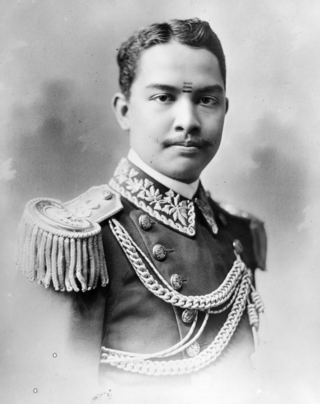
Field Marshal Sir Kaiser Shumsher Jang Bahadur Rana was a field marshal in the Royal Nepalese Army. He was the third son of Maharaja Sir Chandra Shamsher Jang Bahadur Rana, the fifth Prime Minister of Nepal of the Rana dynasty and Bada Maharani Chandra Loka Bhaktha Rajya Lakshmi.

Sir Baber Shumsher Jung Bahadur Rana was a member of the Rana dynasty who served as the Minister of Defence of Nepal in 1951. A prominent member of the Rana oligarchy, he fought valiantly in the First World War. He was the second son of Maharaja Sir Chandra Shamsher Jang Bahadur Rana and Bada Maharani Chandra Loka Bhakta Lakshmi Devi. He was the younger brother of Maharaja Sir Mohan Shamsher Jang Bahadur Rana and older brother of Field Marshal Sir Kaiser Shamsher Jang Bahadur Rana.

The Narayanhiti Palace Museum is a public museum in Kathmandu, Nepal located east of the Kaiser Mahal and next to Thamel. The museum was created in 2008 from the complex of the former Narayanhiti Palace following the 2006 revolution. Before the revolution, the palace was the residence and principal workplace of the monarch of the Kingdom of Nepal, and hosted occasions of state.
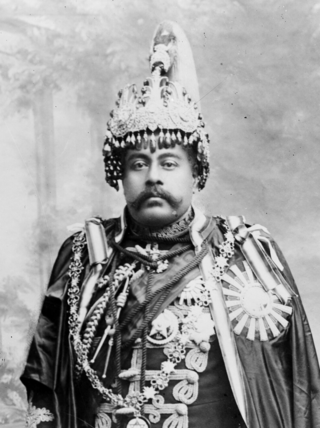
Field Marshal Shri Shri Shri Maharaja Sir Juddha Shumsher Jung Bahadur Rana GCB GCSI GCIE was the Prime Minister of Nepal from 1 September 1932 to 29 November 1945 as the head of the Rana dynasty.

Ranighat Palace or Rani Mahal is a historic Rana palace located on the banks of Kali Gandaki River in Palpa district of Nepal. This palace was constructed by General Khadga Shamsher Jang Bahadur Rana in 1893.

Thapathali Durbar was a palace complex in Kathmandu, the capital of Nepal. Thapathali means abode of the Thapas. It was initially built by Nain Singh Thapa of the Thapa dynasty but was later occupied by Jung Bahadur Rana, as prime minister, the executive head of Nepal. The palace complex, located north of the Bagmati river, encompasses an impressive and vast array of courtyards, gardens, and buildings. Many palaces and buildings were built throughout late 1840s to 1900, initially by Nain Singh Thapa, a member of the aristocratic Thapa family and brother of Bhimsen Thapa, and later was acquired by Nain Singh Thapa's grandson Jung Bahadur Rana. Further additions were made by successive Ranas up to the 19th century.
The following is a timeline of the history of the city of Kathmandu, Nepal.

Babar Mahal, Baber Mahal is a Rana palace in Kathmandu, the capital of Nepal.
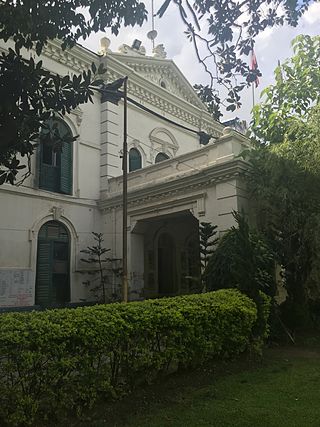
Bag Durbar, is a palace in Kathmandu, Nepal, west of the Dharahara and Tundikhel. Initially the palace was owned by Amar Singh Thapa (Sardar) of the Thapa regime and his descendant, but later was occupied by the Royals of the Shah dynasty and the government of Nepal.

Bahadur Bhawan is a Rana palace in Kathmandu, the capital of Nepal. The palace was built by Bir Shumsher JBR and rebuilt by Rudra Shumsher JBR after its destruction by fire in BS 1962.

Lal Durbar is a Rana palace in Kathmandu, the capital of Nepal. The palace complex, located East of the Narayanhity Palace, was incorporated in an impressive and vast array of courtyards, gardens and buildings. Lal Durbar was built by Bir Shamsher JBR in 1890 CE.

Seto Durbar was a Rana palace in Kathmandu, the capital of Nepal, located south of the Narayanhity Palace. It was built by Bir Shumsher Jung Bahadur Rana in 1893 CE.
Jaulakhel Durbar was a Rana palace in Jawalakhel, Lalitpur, the capital city of Nepal. Jaulakhel Durbar was built by Bir Shumsher Jang Bahadur Rana in 1954 BS.

Lazimpat Durbar, Aka Agni Bhawan is a palace complex in Kathmandu, the capital of the Nepal. Initially build and occupied by Kaji Bir Keshar Pande but later palace area was occupied by Bir Shumsher JBR, as prime minister the executive head of Nepal. The palace complex, located next to the historic Narayanhity Palace Museum, was incorporated impressive and vast array of courtyards, gardens and buildings.

Tansen Durbar, also known as Palpa Durbar & Museum, is a historical palace and a museum. It was built in 1927 by Pratap Shamsher Jang Bahadur Rana. The Durbar is a grand palace in the town of Tansen, Nepal. It was the seat of the Rana governors during the Rana rule in Nepal.

Manohara Durbar was a seven-storied Rana palace in Manohara, Kathmandu, the capital of Nepal. The palace complex was located 12 kilometres (7.5 mi) Southeast of the core of Kathmandu. It included a vast array of courtyards, gardens, and buildings.
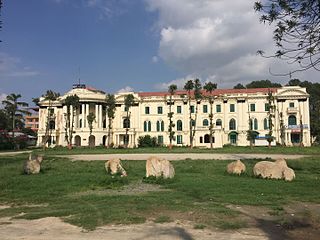
Sita Bhawan is a Rana palace in Kathmandu, the capital of Nepal. The palace complex, located east of the Narayanhity Palace, was incorporated in an impressive and vast array of courtyards, gardens and buildings. Sita Bhawan was built by Bhim Shamsher Jang Bahadur Rana in 1929 for his wife, Her Highness Sri Teen Sita Bada Maharani Deela Kumari Devi.

Harihar Bhawan is a Rana palace in Patan, the capital of Nepal. The palace complex, located west of the Shree Durbar, was incorporated into a vast array of courtyards, gardens and buildings.




















